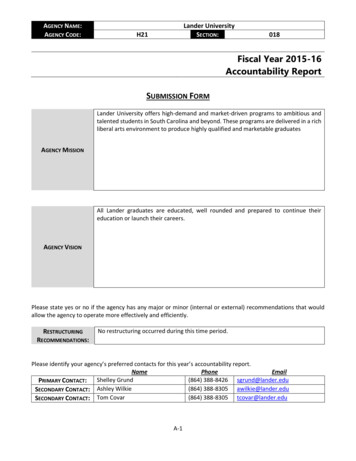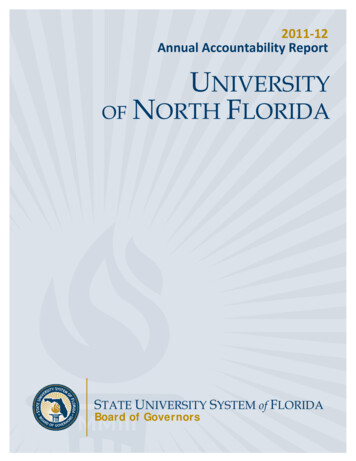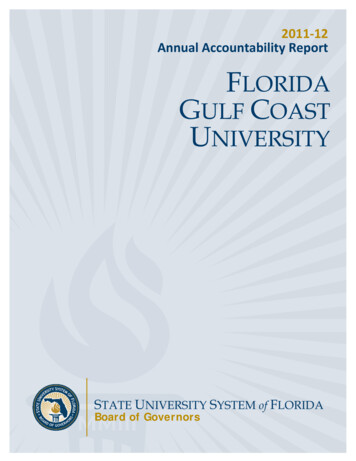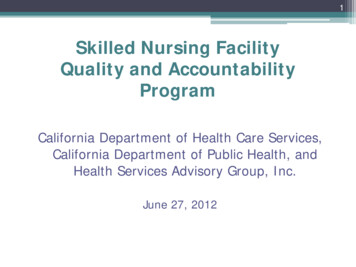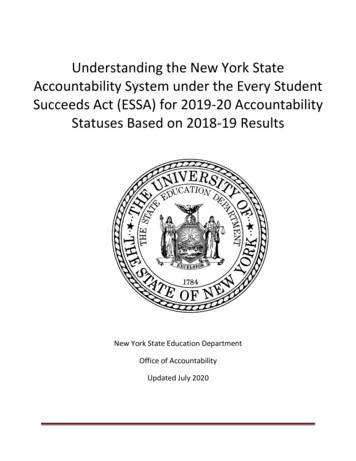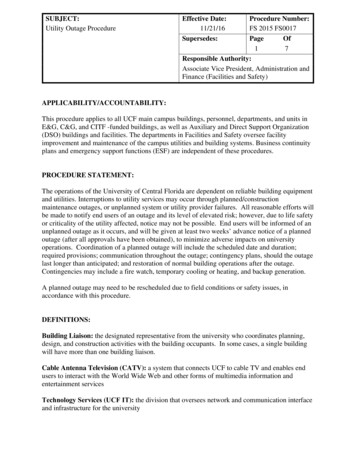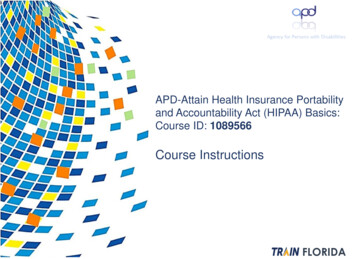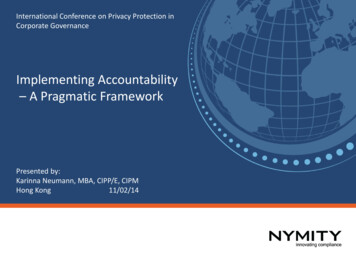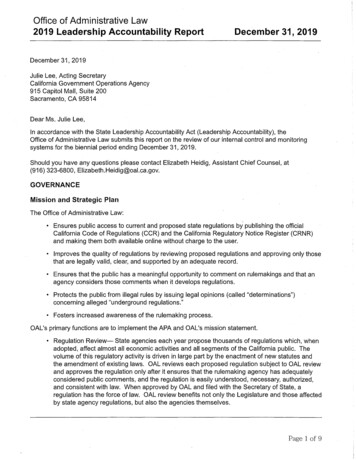
Transcription
Office of Administrative Law2019 Leadership Accountability ReportDecember 31, 2019December 31, 2019Julie Lee, Acting SecretaryCalifornia Government Operations Agency915 Capitol Mall, Suite 200Sacramento, CA 95814Dear Ms. Julie Lee,In accordance with the State Leadership Accountability Act (Leadership Accountability), theOffice of Administrative Law submits this report on the review of our internal control and monitoringsystems for the biennial period ending December 31, 2019.Should you have any questions please contact Elizabeth Heidig, Assistant Chief Counsel, at(916) 323-6800, Elizabeth.Heidig@oal.ca.gov.GOVERNANCEMission and Strategic PlanThe Office of Administrative Law: Ensures public access to current and proposed state regulations by publishing the officialCalifornia Code of Regulations (CCR) and the California Regulatory Notice Register (CRNR)and making them both available online without charge to the user. Improves the quality of regulations by reviewing proposed regulations and approving only thosethat are legally valid, clear, and supported by an adequate record. Ensures that the public has a meaningful opportunity to comment on rulemakings and that anagency considers those comments when it develops regulations. Protects the public from illegal rules by issuing legal opinions (called "determinations")concerning alleged "underground regulations." Fosters increased awareness of the rulemaking process.OAL's primary functions are to implement the APA and OAL's mission statement. Regulation Review- State agencies each year propose thousands of regulations which, whenadopted, affect almost all economic activities and all segments of the California public. Thevolume of this regulatory activity is driven in large part by the enactment of new statutes andthe amendment of existing laws. OAL reviews each proposed regulation subject to OAL reviewand approves the regulation only after it ensures that the rulemaking agency has adequatelyconsidered public comments, and the regulation is easily understood, necessary, authorized,· and consistent with law. When approved by OAL and filed with the Secretary of State, aregulation has the force of law. OAL review benefits not only the Legislature and those affectedby state agency regulations, but also the agencies themselves.Page 1 of 9
Office of Administrative Law2019 Leadership Accountability ReportDecember 31, 2019 Regulation Publication- OAL, through OAL's vendor Thompson Reuters (Barclays), providesfor the official publication of all approved regulations in the CCR, the recognized source ofregulatory law in California. Notice Publication- OAL is responsible for an additional publication, the CRNR, whichcontains, amon.g other things, Notices of Proposed Regulatory Action, and notifications to thepublic of various OAL and state agency decisions and pending actions related to regulations(Gov. Cod , sec. 11344.1 ). Education and Training- OAL promotes public participation in APA rulemaking by respondingto public inquiries and providing ongoing training to state agency staff on appropriate andefficient rulemaking and the public's role in the process. Public Awareness and Information- OAL maintains a home page on the Web to inform thepublic of OAL's mission and functions and other helpful information, such as what emergencyregulatory actions are pending, and provides a portal for public contact with OAL. OALmaintains a reference attorney service to answer questions from the public and governmentagencies. Determinations Regarding "Underground Regulations"- After receiving a formal request froman interested person, OAL may issue a legal opinion determining whether agency rules are"underground regulations" which must be adopted according to APA procedures, includingpublic comment and OAL review.There are no entities that report to OAL.Control EnvironmentONGOING MONITORINGAs the head of OAL, Kenneth J. Pogue, Director, is responsible for the overall establishment andmaintenance of the internal controls and monitoring systems.EXECUTIVE MONITORING SPONSORSThe executive monitoring sponsors' responsibilities include facilitating and verifying that OAL's internalcontrol monitoring practices are implemented and functioning as intended. The responsibilities for theexecutive monitoring sponsors have been given to: Kenneth J. Pogue, Director, Elizabeth Heidig,Assistant Chief Counsel (currently taking on some of the responsibilities of the Deputy Director as thatposition is vacant), and Belinda Lindstrom, Staff Services Manager II (SSM 11).Management establishes ethical values. This is addressed by OAL attorneys complying with theCalifornia State Bar Code of Ethics and all staff taking Ethics training every two years. All staff meetmonthly to discuss issues of concern (including ethical issues. As OAL is a small office with· only 21authorized positions, every employee has direct access to the Assistant Chief Counsel and theDirector. OAL also conspicuously posts its Code of Conduct in the workplace. Oversight is provided bymanagement by personally interacting with each employee every week. Any issues raised areaddressed during weekly scheduled attorney meetings and monthly all staff meetings. OAL has acomprehensive workplace manual that is updated regularly and provided to all staff. While OAL rarelyPage 2 of 9
Office of Administrative Law2019 Leadership Accountability ReportDecember 31, 2019has vacancies, OAL works with DGS to appropriately target recruitment efforts to fill vacancies andcross training existing employees to ensure that OAL's workforce is competent to handle OAL's missioncritical functions and that all duties can be handled by multiple personnel. Management regularlyprovides performance guidance through the weekly file review process as well as daily assignmentfeedback by the Director and Senior Counsel. OAL has also established a yearly performance reviewprocess for all employees.Information and CommunicationCommunicationOAL communicates internally through regular management meetings and monthly legal divisionmeetings, as well as through detailed written policies and procedures for both the legal staff andsupport staff, checklists for legal review, and confidential legal memorandums. Any identifieddeficiencies are handled directly with key staff and, when appropriate, groups of staff in an effort tofurther enhance quality and productivity in addressing statutory responsibilities and increasing public/departmental outreach and response.All employees are encouraged to report inefficiencies, inappropriate actions, and/or ethical concerns totheir supervisor, or any manager/supervisor they feel comfortabls with. In addition, all employees haveopen and direct access to the Director.Other channels of communication include: Regularly held trainings (both on rulemaking and underground regulations) OAL Reference Attorney - responds to inquiries from the public and state agencies Underground Regulations Attorney- responds to questions concerning potential undergroundregulations External Stakeholders -Access through the OAL Reference Attorney, Assistant Chief Counsel,Deputy Director and Director (when appropriate)[1][1] OAL intends to provide additional External Stakeholder training for participation in the rulemakingprocess in 2020.[2] ProLaw is a Legal Practice Management, Document Management for OAL.MONITORINGThe information included here discusses the entity-wide, continuous process to ensure internal controlsystems are working as intended. The role of the executive monitoring sponsor includes facilitating andverifying that the Office of Administrative Law monitoring practices are implemented and functioning.The responsibilities as the executive monitoring spons or(s) have been given to:Elizabeth Heidig, Assistant Chief Counsel; and Kenneth Pogue, Director.The monitoring of OAL's responsibility of meeting statutory and regulatory deadlines, as well as thedemonstration and monitoring of ethical codes of conduct, continues on a daily basis by the Director.The Director meets daily with key staff and holds monthly meetings to identify internal and externalcontrol issues and mitigation strategies for implementation. Additionally, the Director holds ey legalstaff conferences on an as-needed basis (but at least weekly) to address organizational goals,Page 3 of 9
Office of Administrative Law '2019 Leadership Accountability ReportDecember 31, 2019objectives and risks.Reporting and Documenting Monitoring ActivitiesThe Director, Deputy Director, and Assistant Chief Counsel (OAL does not have a chief counselposition) determine whether statutory and regulatory deadlines have been met by monitoring e-mailnotifications, database auto-notifications, and confidential file review memos written by legal staff to theexecutive file review committee. The executive file review committee consists of the Director, DeputyDirector, Assistant Chief Counsel, and at least one Senior Attorney. The Director monitors the officeworkload of the legal staff on a weekly basis, or on a daily basis if needed, using a report compiled bysupport staff.- OAL's SSM II, with the assistance of the Department of General Services' (DGS) staff, drafts the OALbudget, which is reviewed and approved by the Deputy Director and the Director.The SSM II meets with the Director on a weekly basis, or more often as needed; and reports on thecurrent progress of non-payments of state agency invoices, accounts payable, staffing, and the ongoingworking relationship with Department of Finance (DOF), DGS, and Fi Cal. The Director meets withmanagement staff on a weekly basis, or more often if the circumstances require, such as, when theoffice is in the process of filling a vacant position.The monitoring of purchases is the responsibility of the Associate Governmental Program Analyst(AGPA), as overseen by the SSM 11, and facilitated by the implementation and use of the Fl Calsystem. The AGPA reviews and processes purchase orders, and the Director reviews and approvesthem as appropriate.·The monitoring of non-payment of invoices for payments owed to OAL continues on a daily basis and isoverseen primarily by the SSM II.The monitoring of the staffing level at OAL is ongoing and increases as vacancies become imminent.The Director meets with other management staff as the need arises. The AGPA and SSM II meetquarterly with DGS to discuss new processes and/or procedures in accounting regarding Fi CAL, andto discuss issues that may be at hand and any other concerns that might arise through theseinteractions with DGS. The SSM II then meets with the Deputy Director and the Director to review anddiscuss any relevant changes.Addressing Identified Internal Control DeficienciesVulnerabilities identified during ongoing monitoring are reported to the executive monitoring sponsorsfor discussion and resolution. Being a small office of 22 positions (19 filled), with a flat management/hands-on style, OAL is able to act quickly in response to any deficiencies that appear during anymonitoring activity or otherwise. Corrective actions are taken to ensure identified vulnerabilities arecorrected, weaknesses are identified, and proactive measures are taken. OAL procedures now requirereview and approval on three levels for expendi{ures: First, by the SSM II Second, by the Deputy Director, or by the Assistant Chief Counsel (when the Deputy Directorposition is vacant) Third, by the DirectorPage 4 of 9
Office of Administrative Law2019 Leadership Accountability ReportDecember 31, 2019Furthermore, OAL continues to cross-train staff on core functions to ensure coverage in the event OALloses a key employee.[1] ProLaw is a Legal Practice Management, Document Management and Accounting program for lawfirms. SKASSESSMENTPROCESSThe following personnel were involved in the Office of Administrative Law risk assessment process:executive management, middle management, front line management, and staff.The following methods were used to identify risks: brainstorming meetings, and ongoing monitoringactivities.The following criteria were used to rank risks: likelihood of occurrence, potential impact to mission/goals/objectives, potential impact of remediation efforts, and tolerance level for the type of risk.RISK IDENTIFICATIONBecause OAL is a small agency with a collegial staff of attorneys, legal analysts, and support staff,OAL's executive team uses a hands-on, direct communication approach toward management of theoffice. OAL does not have an internal auditor, but does contract with DGS for specified services inInformation Technology and Human Resources, including auditing and audit reporting. OAL's riskassessment was performed by engaging in a series of informal, but comprehensive discussions andreview of risks that could potentially affect OAL's ability to perform its core mission. After conductingthe assessment, the executive team identified the issues described herein as representing thesignificant risks facing the agency. The assessment of each risk and plans for addressing each risk arealso discussed within this report.RISK RANKINGOAL prioritizes any potential risks so that significant internal control deficiencies are remedied on atimely basis with the focus being on OAL meeting the statutory and regulatory deadlines andobligations of OAL's core mission.RISKS AND CONTROLSRisk: RECRUITMENT, RETENTION AND TRAINING OF STAFFStaff Recruitment and Retention - Over the years, retaining experienced and knowledgeable attorneysin the APA rulemaking process is what has enabled OAL to meet its statutory deadlines during regularperiods of heavy workload. There is a concern about retaining experienced and knowledgeableattorneys and support staff. This can be a challenge given that out of the 11 attorney positions, OALdoes not have any Attorney IV positions available, and very few opportunities for attorneys or supportstaff to promote within OAL. Other state agencies have Attorney IV regulatory positions and biggeragencies have many opportunities for support staff to advance. Thus, openings in other state agenciesmay be attractive to our attorneys and support staff.· Key Person dependence and staff recruitment and training is a potential risk for OAL. Three of OAL'sPage 5 of 9
Office of Administrative Law2019 Leadership Accountability ReportDecember 31, 2019most experienced attorneys retired in the last five years (two in 2019), and it is anticipated that thistrend will continue as OAL has at least two additional attorneys who have indicated their intention toretire within the next few years. Because OAL has a small legal staff of 11 reviewing attorneys andthree management level attorneys, each departure of an experienced attorney has a significant impacton the legal experience and historical knowledge of OAL. In addition, newer attorneys have indicated adesire for promotional opportunities which do not currently exist at OAL.Inadequate staffing levels could prevent OAL from meeting its statutory and regulatory deadlines andobligations. The number of actions submitted by state agencies to OAL for review has increased. Since2013, there has been an approximately 21 percent increase in the number of actions submitted to OALfor review. Inadequate staffing levels could prevent OAL from meting its statutory and regulatoryobligations.In addition, OAL's attorneys should be receiving regular outside training in multiple areas, includinglegal review and writing. OAL will need to seek augmentation of its budget as the current budget doesnot support such necessary training.Control: AIncrease in workload and the loss of seasoned staff impacts the ability for OAL to meet statutoryand regulatory deadlines in a consistent and most effective manner. OAL manages this risk·through individual training and cross-training, and monitoring of each individual's ability to meetdeadlines. To minimize this risk, OAL will need a budget augmentation to sustain the currentprogram-level expectations and to increase staffing and promotional opportunities to ensure thatOAL will be able to meet statutory obligations and respond to the additional demands on a smallagency, as well as to provide for training to its attorneys.Risk: Budget: Internal and External RisksOAL is a small office with a tight budget. It is very difficult for OAL to absorb unexpected increases inexpenditures making it very difficult to operate within its authorized budget. Specific internal risks areas follows:1. OAL has a number of employees who are near retirement age and at the top of theirpayscales. These employees also have high leave balances. When these employees retire and theirleave balances paid out, it will significantly impact OAL's operating budget and its ability to backfillpositions.2. OAL needs to retain knowledgeable employees. In order to do so, OAL must upgrade positions.The cost increases for the upgraded positions are absorbed within OAL's existing budget. However,maintaining its staffing levels makes it a challenge to remain within its authorized budget.OAL has external risks to its budget because it contracts out for human resources, accounting, budgetand IT services. This leaves OAL dependent on other departments that may increase the costs of theirservice contracts which OAL will have to absorb within its existing budget.Control: AIt is critical for OAL to maintain a highly knowledgeable and ,experienced staff to achieve itsPage 6 of 9
Office of Administrative Law2019 Leadership Accountability ReportDecember 31, 2019mission. If OAL does not retain the appropriate staff, the critical oversight of agency rulemaking tomeet the applicable State Standards will not occur. Management strives to maintain aknowledgeable and experienced workforce while staying within its authorized·budget. Management meets internally each week, or more often if necessary, to review anddiscuss its budget. Management also meets monthly to review its internal monthly expenditurereport.OAL communicates with DGS on a daily or as needed basis. OAL provides DGS with the timelysubmittal of information and supporting documentation necessary for DGS to perform itsservices. OAL has regularly scheduled monthly meetings with DGS to discuss its budget activities,respond to DOF's miscellaneous budget drills and to build its annual budget.·OAL identified and implemented cost saving measures through cancellation of non-usepublications to cover the costs of the position upgrades. OAL,is seeking the necessary resourcesto maintain its key staff to perform its critical mission functions.Risk: Computer SystemOAL's statutorily mandated review of rulemakings requires a quick and thorough legal review. OALcurrently relies on multiple state agencies to provide operational infrastructure and support. OAL staffregularly experience disruptions in this infrastructure which results in unplanned down time for staff.This inhibits OAL review and creates inefficiencies in the performance of OAL's core functions. OAL'sreliance on multiple state agencies for this infrastructure and support frequently results in delays. Inaddition, attorneys, instead of IT staff (OAL has no IT staff), are asked to address IT-related problems,taking them away from their primary duties.Control: AOAL is currently in the process of working with involved state agencies to resolve infrastructureissues and to establish a more streamlined approach to providing services to minimize futureinfrastructure disruptions and to minimize recovery time when disruptions do occur. In addition,OAL contracts with DGS for IT support. DGS-IT reviews and submits all required InformationReporting, such as the Statewide Information Management Manual (SIMM) Reports.Risk: Compliance w/ Web Content Accessibility GuidelinesThe Americans with DisabilityAct (ADA) and Government Code section 11546.7 requires each stateagency to post on the homepage of the agency's Internet Web site a signed certificatio
[1] ProLaw is a Legal Practice Management, Document Management and Accounting program for law firms. SKASSESSMENTPROCESS The following personnel were involved in the Office of Administrative Law risk assessment process: executive managem

